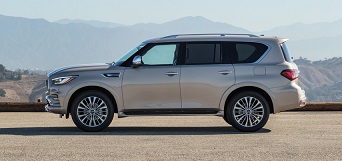Key specs
Infiniti QX80 (SUV) QX80 (facelift 2017) 2017,2018,2019,2020,2021,2022,2023,2024,2025,2026
What is the body type, Infiniti QX80 (facelift 2017) 5.6 V8 (400 Hp) AWD Automatic 2017?
SUV, 5 Doors, 44780 Seats
How much power, Infiniti QX80 (facelift 2017) 5.6 V8 (400 Hp) AWD Automatic 2017?
400 Hp @ 5800 rpm.
72 Hp/l
What is the engine size, Infiniti QX80 (facelift 2017) 5.6 V8 (400 Hp) AWD Automatic 2017?
5552 cm3
338.8 cu. in.
How many cylinders, Infiniti QX80 (facelift 2017) 5.6 V8 (400 Hp) AWD Automatic 2017?
8,
V-engine
What is the drivetrain, Infiniti QX80 (facelift 2017) 5.6 V8 (400 Hp) AWD Automatic 2017?
All wheel drive (4x4),
How long is this vehicle, Infiniti QX80 (facelift 2017) 5.6 V8 (400 Hp) AWD Automatic 2017?
5339 mm
210.2 in.
How wide is the vehicle, Infiniti QX80 (facelift 2017) 5.6 V8 (400 Hp) AWD Automatic 2017?
2029 mm
79.88 in.
What is the curb weight, Infiniti QX80 (facelift 2017) 5.6 V8 (400 Hp) AWD Automatic 2017?
2671 kg
5888.55 lbs.
Infiniti QX80 (SUV) QX80 (facelift 2017) 2017,2018,2019,2020,2021,2022,2023,2024,2025,2026 Specs
General information
| Brand |
Infiniti |
| Model |
QX80 (SUV) |
| Version |
QX80 (facelift 2017) |
| Engine version |
5.6 V8 (400 Hp) AWD Automatic |
| Year production start |
2017 |
| Vehicle type |
SUV |
| Horsepower RPM |
400 Hp @ 5800 rpm. |
| Curb weight kg -lbs total |
2671 kg
5888.55 lbs.
|
| Overall length mm - inch |
5339 mm
210.2 in.
|
| Doors |
5 |
Engine specs
| Designation model |
VK56VD |
| Cam configuration |
DOHC
|
| Engine position and orientation |
Front, Longitudinal |
| Cylinders |
8 |
| Position of cylinders |
V-engine |
| Displacement (liters) |
5552 cm3
338.8 cu. in.
|
| Eng. horsepower RPM |
400 Hp @ 5800 rpm.
|
| Horsepower per litre |
72 Hp/l
|
| Weight / horsepower kg/hp - hp/tons |
6.7 kg/Hp
149.8 Hp/tonne
|
| Weight / torque kg/Nm - Nm/tons |
4.8 kg/Nm, 209.7 Nm/tonne
4.8 kg/Nm
209.7 Nm/tonne
|
| Torque Nm RPM lb-ft RPM |
560 Nm @ 4000 rpm.
413.03 lb.-ft. @ 4000 rpm.
|
| Bore (mm in) |
98 mm
3.86 in.
|
| Stroke (mm in) |
92 mm
3.62 in.
|
| Compression ratio |
11.2 |
| Fuel delivery system |
Direct injection |
| Fuel type |
Petrol (Gasoline) |
| Valvetrain |
4 |
| Engine aspiration |
Naturally aspirated engine |
| Engine oil liters | quarts |
6.5 l
6.87 US qt | 5.72 UK qt
|
| Engine coolant |
16.2 l
17.12 US qt | 14.25 UK qt
|
| Powertrain architecture |
Internal Combustion engine |
| Engine location |
Front, Longitudinal
|
Transmission and Drive system
| Drive configuration |
All wheel drive (4x4)
|
Brakes
| Front brakes |
Ventilated discs |
| Rear brakes |
Ventilated discs |
| Anti-lock brake system |
ABS (Anti-lock braking system) |
Steering
| Steering type |
Steering rack and pinion |
| Turning diameter m - ft |
12.5 m
41.01 ft.
|
Suspension
| Front suspension |
Double wishbone |
| Rear suspension |
Double wishbone |
Wheels & Tyres
| Wheels size |
275/60 R20
|
| Wheels rims |
8.0J x 20 |
Passenger
| Passengers seats |
44780 |
| Trunk space min liter | cu. Ft. |
470 l
16.6 cu. ft.
|
| Trunk space max liter | cu. Ft. |
2693 l
95.1 cu. ft.
|
Dimensions
| Overall length mm - inch |
5339 mm
210.2 in.
|
| Overall width mm -inch |
2029 mm
79.88 in.
|
| Overall height mm -inch |
1925 mm
75.79 in.
|
| Wheelbase mm - inch |
3076 mm
121.1 in.
|
| Track width front mm - inch |
1715 mm
67.52 in.
|
| Track width rear mm - inch |
1725 mm
67.91 in.
|
| Coefficient of drag |
0.36
|
Weights
| Curb weight kg -lbs total |
2671 kg
5888.55 lbs.
|
| Gross weight kg -lbs total |
3402 kg
7500.13 lbs.
|
| Capacities kg - lbs |
731 kg
1611.58 lbs.
|
| Fuel tank liters | gallons |
98 l
25.89 US gal | 21.56 UK gal
|
Fuel economy
| Urban (NEDC) l/100 km - Mpg |
18 l/100 km
13.07 US mpg
|
| Extra urban (NEDC) l/100 km - Mpg |
12.3 l/100 km
19.12 US mpg
|
| Combined (NEDC) l/100 km - Mpg |
15.6 l/100 km
15.08 US mpg
|
| Autonomy km (combined use) NEDC |
6533?333333 |
Engine type
8 CYLINDER V-Engine
https://www.thecarspec.net/components/engine/8-cylinders-v

